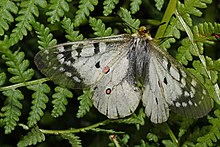Parnassius smintheus
| Rocky Mountain parnassian | |
|---|---|
 |
|
| Scientific classification | |
| Kingdom: | Animalia |
| Phylum: | Arthropoda |
| Class: | Insecta |
| Order: | Lepidoptera |
| Family: | Papilionidae |
| Genus: | Parnassius |
| Species: | P. smintheus |
| Binomial name | |
|
Parnassius smintheus Doubleday, [1847] |
|
Parnassius smintheus, the Rocky Mountain parnassian, or Rocky Mountain apollo, is a high-altitude butterfly found in the Rocky Mountains throughout the United States and Canada. It is a member of the snow Apollo genus (Parnassius) of the swallowtail family (Papilionidae). The butterfly ranges in color from white to pale yellow-brown, with red and black markings that indicate to predators that its body contains chemicals that make it distasteful to eat.
The Parnassius smintheus primarily feed on the leaves of the Sedum lanceolatum plant as larvae and on its nectar as adults. The butterfly tends to reside in meadows, and avoids forests, because it strongly prefers light. The males of this species fly from meadow to meadow frequently to find females and food resources, whereas females are more likely to avoid flying. The males seem to have mate choice in this species, as they emerge from the pupae earlier than the females and patrol for females, heavily preferring newly emerged females that have not yet flown.
Although the Parnassius smintheus populations are not endangered yet, due to climate change and human activity, there has been a decrease in viable habitats in the last few decades for the species that is projected to continue in the future.
The range of the butterfly is based primarily in the Rocky Mountains, which spans Canada and the United States. This includes the mountainous areas of Yukon, Alaska, and British Columbia in Canada, and south as far as New Mexico in the United States.
...
Wikipedia
